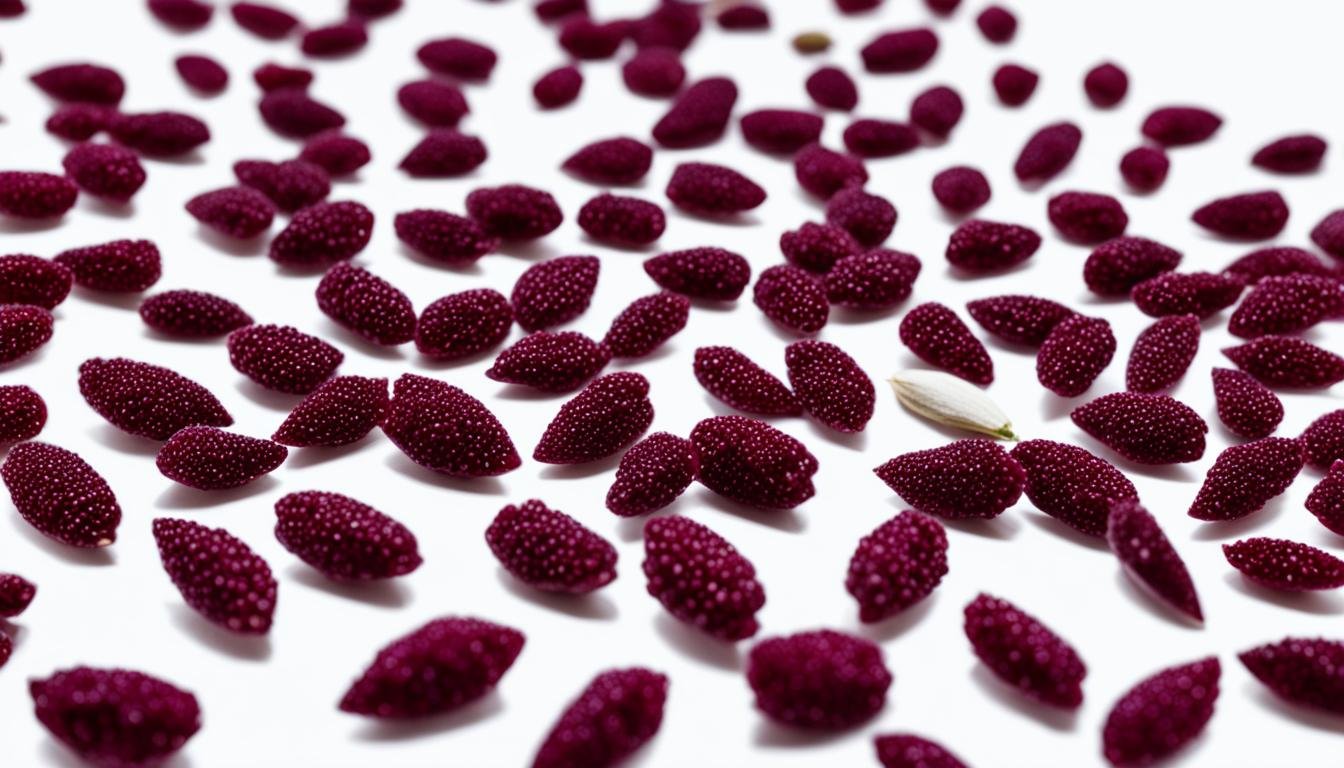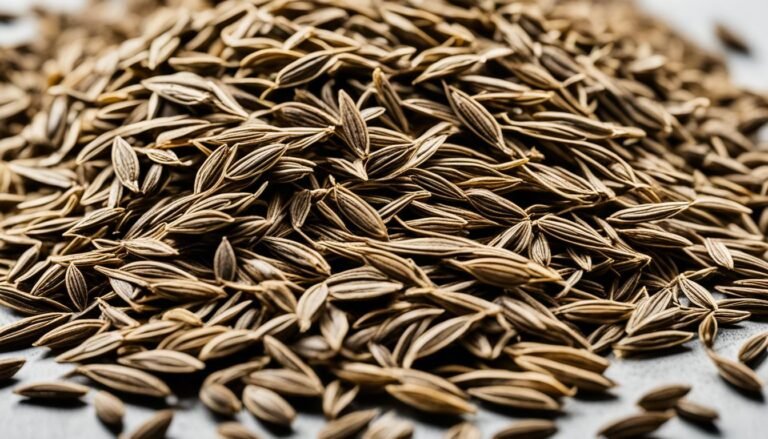Storing Amaranth Seeds: Essential Tips & Tricks

Are you into gardening or cooking at home and want to keep your amaranth seeds fresh? Storing them right is key to keeping them good and usable. We’ll share top tips and tricks for storing amaranth seeds. This way, you can enjoy their health benefits for a long time.
Amaranth is a grain full of nutrients that’s becoming more popular. It’s great for cooking and is good for your health. If you’ve grown your own or bought it, storing it right is important. This guide will teach you how to keep amaranth seeds fresh and usable for a long time.
Introduction to Amaranth
Amaranth is a special plant that people have grown for thousands of years, mainly in Mesoamerica. It was a key food for the Aztecs. But, its use dropped after the Spanish Conquest, when it was banned. Now, it’s becoming popular again.
What is Amaranth?
Amaranth is a plant that gives us leaves, stems, and seeds to eat. Its small grains are full of protein and important nutrients like calcium, iron, and magnesium. This makes amaranth a great food for health.
Historical Background of Amaranth
Amaranth has a long history in Mesoamerica. The Aztecs ate it and saw it as important for health and spirit. But, after the Spanish took over, growing amaranth was banned. Now, people are learning about its health benefits again.
Nutritional Benefits of Amaranth
Amaranth is very nutritious and has a lot of protein. Studies show that amaranth seeds have 14-16% protein. It also has important minerals like calcium, iron, and magnesium. These make amaranth a great food for a healthy diet.
Tips for Storing Amaranth Seeds
Storing amaranth seeds right is key to keeping them fresh and usable for a long time. By using these tips, you can keep your amaranth seeds in top condition. This ensures you always have a steady supply of this healthy grain.
Amaranth seeds are small and can be cooked like quinoa. Here are some important points to remember for storing them:
- Use Airtight Containers: Keep your amaranth seeds in containers that seal tightly, like glass jars or mylar bags. This keeps them safe from moisture and air. It helps keep the seeds fresh and stops them from going bad.
- Maintain Ideal Moisture Levels: Store amaranth seeds in a place that’s cool and dry, with low humidity. Too much moisture can cause mold and make the seeds germinate too soon, shortening their shelf life.
- Control Temperature: The best place for storing amaranth seeds is in a cool, dry spot, like a pantry or fridge. Don’t put them where they can get direct sunlight or heat, as this can lower their quality.
- Prevent Pest Infestations: Amaranth seeds can attract pests like weevils or moths. Always check your storage regularly. You can also use natural ways to keep pests away, like adding a bay leaf or freezing the seeds for a few days.
By keeping these tips in mind for storing amaranth seeds, you can make sure they stay nutritious and usable for a long time. Whether you grow your own or buy it, proper storage is crucial. This way, you can fully enjoy this versatile and healthy grain.
Proper Storage Containers for Amaranth Seeds
Keeping your amaranth seeds fresh and viable is key for a good harvest. You need the right containers for this. Airtight, moisture-resistant containers are perfect for keeping your amaranth seeds in great shape.
Airtight Containers
Heavy-duty, food-grade plastic containers are great for storing amaranth seeds. They seal tightly, keeping air and moisture out. This keeps the seeds’ natural oils and nutrients in, making them last longer.
Glass Jars or Mylar Bags
Glass jars with tight lids are also good for storing amaranth seeds. They let you see the seeds and are strong. Or, you could use mylar bags for amaranth seeds. These bags block air and moisture, keeping your seeds fresh.
| Storage Container | Advantages | Disadvantages |
|---|---|---|
| Airtight Plastic Containers | Provides an airtight seal Protects seeds from air and moisture Durable and reusable | May not be as transparent as glass Potential for plastic to degrade over time |
| Glass Jars | Transparent for easy monitoring Airtight seal with tight-fitting lids Durable and reusable | Can be more fragile than plastic May be heavier to store and transport |
| Mylar Bags | Excellent barrier against air and moisture Lightweight and easy to store Can be vacuum-sealed for maximum freshness | May not be as durable as rigid containers Require additional storage containers for protection |
When storing your amaranth seeds, choose containers that keep air and moisture out. This keeps your seeds fresh and ready for years. The right storage means your amaranth seeds stay in top condition.
Maintaining Ideal Moisture Levels
Keeping your amaranth seeds fresh and usable starts with the right moisture levels. The ideal moisture for storing amaranth seeds is between 10-12%. Too much moisture can cause mold, spoilage, and lower germination rates. It’s key to dry your seeds to the right level before storing them.
For dry storage, keep your amaranth seeds in a cool, dry place. Stay away from humidity changes, as they can make the seeds lose or gain moisture. By controlling the storage area, you keep the amaranth seed moisture levels right. This helps your seeds stay in great condition for a long time.
Using a hygrometer is a good way to check moisture levels. This device measures humidity. Check the readings often and adjust the storage as needed to keep amaranth seeds dry. This stops moisture problems.
| Storage Condition | Amaranth Seed Shelf Life |
|---|---|
| Stored in an open container in a pantry | 4 months |
| Stored in an airtight container in a freezer | Up to 8 months |
| Stored in an airtight container at cooler temperatures | Several decades |
By keeping the right amaranth seed moisture levels and storing them in a cool, dry spot, your seeds will stay in top shape. This careful handling lets you enjoy your amaranth harvest for a long time.

Optimal Temperature for Amaranth Seed Storage
Storing amaranth seeds right is key to keeping them fresh and ready for planting. It’s important to keep them in a cool, dry place.
Cool and Dry Environment
The best temperature for storing amaranth seeds is between 40°F and 60°F. High temperatures or sunlight can make the seeds go bad faster. This leads to lower germination rates and quality.
Keeping seeds dry is also crucial. Too much moisture can cause mold and bacteria to grow. This harms the seeds.
Storing amaranth seeds in a cool, dry spot helps them last longer. This can be a pantry, basement, or a special seed container. Just make sure the temperature and humidity are right.
| Crop | Average Storage Life (Years) |
|---|---|
| Vegetable Crops | 1 – 6 |
| Buckwheat | 2 – 5 |
| Chives | 1 – 3 |
| Fruit Crops | 3 – 6 |
| Amaranth | 4 – 5 |
| Peas | 2 – 4 |
| Basil | 3 – 5 |
| Cabbage | 3 – 5 |
| Squash & Gourds | 3 – 6 |
| Beans | 2 – 4 |
| Corn (Sweet) | 1 – 3 |
Keeping your amaranth seeds in a cool and dry environment helps them stay fresh. They keep their high nutritional value and are ready for planting. With the right storage, your amaranth seeds can last for years.
Preventing Pests and Infestations
Amaranth seeds can face threats from pests like weevils, moths, and beetles. These pests can harm or spoil the seeds. To keep your amaranth seeds safe, it’s key to act early to stop infestations.
Common Pests that Affect Amaranth Seeds
Here are some pests that target amaranth seeds:
- Spider mites – These tiny pests love dry places and need regular checks to catch early signs of trouble.
- Scale insects – Hard to see, these pests look like bumps. Use a soft brush or alcohol-soaked cotton to control them if they’re many.
- Fungus gnats and fruit flies – These pests do well in wet soil. Cutting back on water helps fight them.
- Mealybugs – These pests leave a cottony mess on plants. Use soapy water, rubbing alcohol, insecticidal soap, or neem oil to get rid of them.
- Aphids – Easy to spot, these pests can be washed away with water, or controlled with soap or neem oil. Watch out for ladybugs, which help fight them.
- Thrips – Tough to see, these pests need careful control, like using predatory mites or neem oil.
Natural Pest Control Methods
Here are ways to fight pests and protect your amaranth seeds:
- Neem oil – This oil works against many pests, acting as an insecticide, miticide, and fungicide.
- Insecticidal soaps – These soaps, made from potassium fatty acids, are good against pests like aphids and spider mites. But, apply them carefully for best effect.
- Beneficial insects – Ladybugs and lacewings can help control pests naturally in your garden.
- Cultural practices – Keeping your plants clean, isolating new plants, and cleaning tools are key to stopping pests in amaranth farming.
- Regular inspections – Check your amaranth seeds often for pests, ensure good air flow, and don’t overcrowd to prevent infestations.

Using these natural methods together can help keep your amaranth seeds safe from pests. This way, you can enjoy a big harvest.
Extending the Shelf Life of Amaranth Seeds
Amaranth seeds have a long shelf life when stored right. With proper storage, they can stay fresh for several years. This means you always have a reliable and nutritious supply. Let’s look at what makes amaranth seeds last longer and how to keep them fresh.
Seed Viability and Longevity
Stored correctly, amaranth seeds can last up to a few years. Several things affect how long your seeds last, including:
- Storage Conditions: The right temperature, humidity, and air flow are key to keeping seeds fresh.
- Moisture Content: The right moisture level is important to avoid germination or spoilage.
- Seed Quality: Starting with fresh, high-quality seeds helps them last longer than older or lower-quality ones.
By following best practices for storing amaranth seeds, you can keep them fresh and ready for use for years.
| Seed Type | Average Shelf Life | Optimal Storage Conditions |
|---|---|---|
| Amaranth Seeds | 2-3 years | Cool (40-50°F), dry, and dark environment |
| Tomato Seeds | 4-5 years | Cool (40-50°F), dry, and dark environment |
| Onion and Chive Seeds | 1-2 years | Cool (40-50°F), dry, and dark environment |
Knowing the storage needs of different seeds helps keep your amaranth seeds and others fresh for years.
Amaranth Seeds for Long-Term Food Storage
Amaranth seeds are great for long-term food storage. They are packed with nutrients and last a long time. They are also very versatile. When stored right, they can be a key part of your emergency food plan.
Amaranth was first grown in Mesoamerica over 4000 years ago. Today, there are more than 60 types of this grain from the Americas. It’s a tough plant that can survive with little water. You can make a tasty porridge with it or use it to make flour that’s full of protein and fiber.
There are many ways to store amaranth, like canning, buckets, or freezing. This superfood is becoming popular again as food production changes. It’s a better choice than wheat for storing food because it’s more compact and nutritious.
| Comparison of Wheat and Amaranth for Long-Term Storage |
|---|
| One loaf of bread uses about three cups of flour, so you’d need 25 pounds of wheat for fifty days. For a long time, you should store 150 pounds of wheat per person. This means over a quarter ton for a family of four. Amaranth seeds, however, are smaller and more nutritious, lasting up to six months when stored right. |
Wheat for storage costs between fifty cents and a dollar per pound. Prices have gone up a lot recently because of droughts, more people wanting it, and inflation. You can buy wheat from local mills or online, including heritage types like Red Fife and White Sonoma.
Amaranth is good for the planet and needs little water or resources. It grows well in many places, making it great for gardens or farms. Plant amaranth seeds after the last frost, when the soil is at least 65°F. Space them 12 to 18 inches apart.
Amaranth seeds can last up to six months if stored right. Adding them to your food storage means you’ll have important nutrients and many food options. It also saves space in your storage area.

Growing and Harvesting Amaranth Seeds
Growing and harvesting amaranth seeds can be rewarding for those wanting to be self-sufficient. It’s an easy crop to grow, doing well in warm climates with good soil. Once the plants are mature, you can harvest the seed heads and separate the seeds from the chaff through winnowing. This way, you get a steady supply of growing amaranth seeds for use and storage.
Planting and Cultivation
Plant amaranth seeds in warm soil after the last frost for best growth. Direct sowing is best because the plants grow fast. They bloom from mid to late July and can get over 6 feet tall. To avoid thick stems, plant them 12-15 inches apart.
Harvesting and Winnowing Amaranth Seeds
Harvest amaranth when ¾ of the flowers are open on the spikes. The harvesting amaranth seeds process includes cutting the seed heads and drying them for about 2 weeks. Then, you can winnowing amaranth seeds by blowing on them to remove the chaff, leaving the seeds behind.
With some effort, you can grow and harvest your own amaranth. This ancient grain is versatile, used for leaves, flowers, and seeds. It’s a great way to enjoy a nutrient-rich crop.
Conclusion
Storing amaranth seeds right is key to keeping them fresh and full of nutrients. This article has given you the best ways to keep your amaranth seeds ready for eating now or later. Amaranth seeds are packed with nutrients and can be used in many dishes, making them a great choice for your pantry or emergency kit.
To keep your amaranth seed storage top-notch, use containers that don’t let air in. Keep the seeds dry and cool. Watch out for pests and stop them before they start. These steps will help your amaranth seeds last longer.
Adding amaranth to your daily meals or saving it for later is easy with the right storage tips. Enjoy the health perks of this amazing grain. Feel secure knowing you have a steady supply of nutritious food ready when you need it.
FAQ
What are the best storage containers for amaranth seeds?
The best containers for amaranth seeds are heavy-duty, food-grade plastic containers, glass jars with tight lids, or mylar bags. These options keep the seeds safe from things that can shorten their shelf life.
What is the ideal moisture content for storing amaranth seeds?
Before storing, amaranth seeds should be dried to 10-12% moisture. Too much moisture can cause mold and lower the seeds’ ability to germinate. Keeping the right moisture level is key for storing amaranth seeds well.
What temperature range is best for storing amaranth seeds?
Store amaranth seeds in a cool, dry place with temperatures between 40°F and 60°F. Heat, sunlight, or high humidity can make the seeds go bad faster. So, pick a spot that keeps these conditions just right.
How can I prevent pests from infesting my amaranth seeds?
To keep pests like weevils, moths, and beetles away, use airtight containers and check them often for pests. Natural ways to control pests, like diatomaceous earth or essential oils, work well without harsh chemicals.
How long can properly stored amaranth seeds remain viable?
If stored right, amaranth seeds can last for several years. How long they last depends on storage conditions, moisture, and seed quality. By storing them correctly, you can keep your amaranth seeds fresh and ready for a long time.






